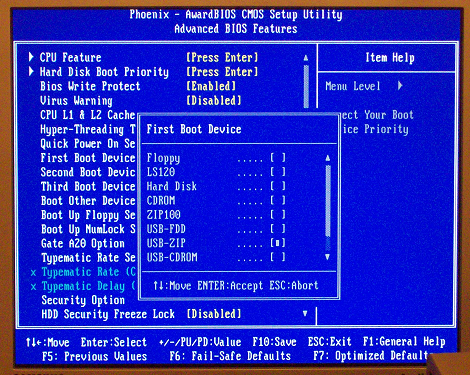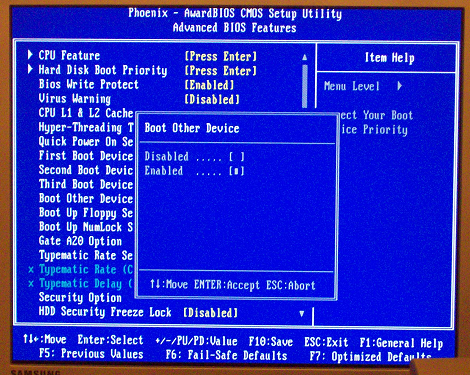System:
Shuttle SB83G5, with FB83 mainboard,
Phoenix-Award BIOS
Medium:
DSL (Linux) stick, FAT32 (512Mb)
Resolved issues with booting the system
In this BIOS there are multiple settings related to booting. The three most logically related are called “First Boot Device”, “Second Boot Device” and “Third Boot Device”. This BIOS offers many options for a Boot Device, but unfortunately there is neither a “USB-memorystick” or a “USB-HDD” setting.

Next there is a setting called “Boot Other Devices”, which can be Disabled or Enabled:

Last there is a screen called “Hard Disk Boot Priority”. This screen is only relevant when you want this system to boot from USB harddisk.
Disabled SATA interface
The test system is equipped with a SATA harddisk. To see with what settings the system can boot from USB stick, I took some tests with a disabled SATA interface. The USB stick was the only USB storage device connected, there was no disc in the CD-ROM drive.
| Boot Other Device | First, Second, Third Boot Device | boots |
|---|---|---|
| Disabled | CDROM, USB-FDD, – | fail |
| Disabled | USB-CDROM, -, – | fail |
| Disabled | USB-FDD, -, – | fail |
| Disabled | USB-ZIP, -, – | USB stick |
| Enabled | CDROM, USB-FDD, – | USB stick |
| Enabled | USB-CDROM, -, – | USB stick |
| Enabled | USB-FDD, -, – | USB stick |
| Enabled | USB-ZIP, -, – | USB stick |
So it appears that there are two ways that allow booting from USB: you can select USB-ZIP as a Boot Device or set Boot Other Device to Enabled.
Enabled SATA interface
So now for a number of tests with the SATA interface enabled:
| Boot Other Device | First, Second, Third Boot Device | boots |
|---|---|---|
| Disabled | -, -, – | fail |
| Disabled | USB-CDROM, -, – | fail |
| Disabled | USB-FDD, -, – | fail |
| Disabled | USB-FDD, HD, – | SATA |
| Disabled | USB-ZIP, -, – | USB † |
| Disabled | USB-ZIP, HD, – | USB » |
| Enabled | -, -, – | SATA |
| Enabled | USB-ZIP, -, – | USB » |
| Enabled | USB-ZIP, HD, – | USB » |
† When the USB stick is not connected, booting fails
» When the USB stick is not connected, the system boots from SATA
So it seems that this BIOS first tries to boot from the configured Boot Devices. If all three fail, and only if Boot Other Device is Enabled, the BIOS tries its own additional sequence of Boot Devices. The USB drive does occur in that sequence, but with a lower priority than the SATA drive.
Conclusion
The boot setting for this system should be:
- First Boot Device: USB-ZIP
- Second Boot Device: CDROM
- Third Boot Device: HD
- Boot Other Device: Enabled
Note 1: When you leave a non-bootable USB drive connected at boottime, the booting process could stop with a message “Non-system disk or disk error, Press any key” or whatever similar message was written to that drive by the software that FORMATted it.
Note 2: This system runs a PS/2 keyboard, USB Legacy device setting: tbd

This does not work at all, I tried the above suggestion. I can not figure out how to make this BIOS boot from the USB stick, and I know the USB stick works in another computer as a bootable device. Its simply frustrating and makes you wonder what the makers of this terrible BIOS were thinking, with no F12 option like the Dell BIOS has and other similar ones. If I disable the hard drive all together from the available devices it can’t find any device to boot from and the system locks up and I have to un-plug and cold boot. Ctrl-Alt-Del does not work, num lock and caps lock keys don’t light so the system is locked up after this. Why did they make this so awful..
Figured it out.
You must go into Integrated Peripherals from the main menu, then OnChip Device Function, then make sure USB Host Controller is Enabled, also you may have to disable or enable USB 2.0 Function if your USB stick does not support USB 2.0. I also had to enable USB Legacy Keyboard Support, as that did not work once I got the USB stick to boot up into it’s operating system, also make sure USB Storage Legacy Support is enabled, right below that option under USB Mass Storage Device Boot Setting (your USB stick’s name should appear after you get the other settings right) you can select HHD mode from a list of options that include, Auto Mode, FDD mode, and HDD mode. Once your memory sticks name shows up under USB Mass Storage Device Boot Setting, go back to Advanced BIOS Features, set the First Boot Device to USB-FDD and go into Hard Disk Boot Priority, you should see a list of hard drives and your USB memory sticks name under USB-HDD0. Highlight it and hit the + key to move it up to number one (1.) position. The other device listed will include Bootable Add-in Cards, this option does not boot from the USB device, I suspect this would be for a network card or other internal device connected to the PCI Slot. Esc back to the main menu and save and exit. Or hit F10.
This took me several hours of fiddling, when I saw my memory sticks name show up under OnChip Device Function menu at the bottom of the page, I knew that the BIOS now saw my USB memory stick and it was a matter of changing the order and priority of the boot devices. Good luck, this is the most convoluted BIOS setup I’ve every worked with..
Markus: BIG thanks!
In my system the options differ but you pointed me to play with the USB options so I finally could boot the memory stick.
It’s 2016, and this reply helped me! LOL! I’m installing Lubuntu Linux on some old PCs at my work, and couldn’t get it to boot from the USB stick until I read this article.
Thanks!
Same here.
I changed a few settings but most were not available. USB now shows up by pressing F12 when booting.
It’s 2021 and it helped me with an older system 🙂
Thank you so much 🙂
Great findings .. thanks a lot, I had a Phoenix AwardBIOS .. got it around 2008/9 perhaps, but it worked with your findings.. In my case it is ‘DEL’ button to press while booting, and then following the above steps.. was able to boot from USB3.1 drive by disabling USB2.0 function and then re-ordering the USB .. Good to get some of these old PC Pentium era back into life with lightweight Linux in 2022 ! Thanks again .. Cheers !
Hello Friends
while booting kali linux through USB pendrive, i am stuck at “verifying dmi pool data usb boot”.
But same bootable USB pendrive works in oter system.Please can you hel me with this?
Karan
Great article. Thanks.
A few other mistakes to avoid.
1. When mounting the ISO on the USB drive make sure it’s not UEFI only. These old boards are obviously not UEFI. I used ‘MBR and UEFI’ mode (using Rufus) to mount the ISO file.
2. My board only booted when the USB drive was plugged into the rear USB ports. That is the ports that are part of the motherboard, rather than those wired up to the case.
3. In Integrated Peripherals I had set the USB to HDD. FDD and Auto didn’t work. I then had to save, exit and reboot back into the BIOS to be able to select my USB drive in the Advanced BIOS features > HDD order.
4. When it works it’s pretty slow. After a pressing ‘any key to boot from USB’ it takes a minute or so for anything to happen. And with a Windows ISO all you get at first is a Windows logo with no indication anything is happening at all for a good few minutes. It looks as if the system has hung but be patient.
Hope that helps someone.
thank you all for your persistence, it worked for me at last, when I ticked the option ‘allow compatibility with old BIOS ‘ within Rufus